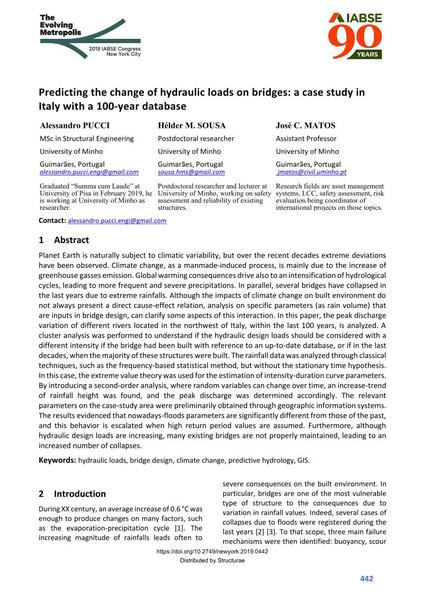Predicting the change of hydraulic loads on bridges: a case study in Italy with a 100-year database

|
|
|||||||||||
Bibliographic Details
| Author(s): |
Alessandro Pucci
(University of Minho)
Hélder S. Sousa José C. Matos |
||||
|---|---|---|---|---|---|
| Medium: | conference paper | ||||
| Language(s): | English | ||||
| Conference: | IABSE Congress: The Evolving Metropolis, New York, NY, USA, 4-6 September 2019 | ||||
| Published in: | The Evolving Metropolis | ||||
|
|||||
| Page(s): | 442-447 | ||||
| Total no. of pages: | 6 | ||||
| DOI: | 10.2749/newyork.2019.0442 | ||||
| Abstract: |
Planet Earth is naturally subject to climatic variability, but over the recent decades extreme deviations have been observed. Climate change, as a manmade-induced process, is mainly due to the increase of greenhouse gasses emission. Global warming consequences drive also to an intensification of hydrological cycles, leading to more frequent and severe precipitations. In parallel, several bridges have collapsed in the last years due to extreme rainfalls. Although the impacts of climate change on built environment do not always present a direct cause-effect relation, analysis on specific parameters (as rain volume) that are inputs in bridge design, can clarify some aspects of this interaction. In this paper, the peak discharge variation of different rivers located in the northwest of Italy, within the last 100 years, is analyzed. A cluster analysis was performed to understand if the hydraulic design loads should be considered with a different intensity if the bridge had been built with reference to an up-to-date database, or if in the last decades, when the majority of these structures were built. The rainfall data was analyzed through classical techniques, such as the frequency-based statistical method, but without the stationary time hypothesis. In this case, the extreme value theory was used for the estimation of intensity-duration curve parameters. By introducing a second-order analysis, where random variables can change over time, an increase-trend of rainfall height was found, and the peak discharge was determined accordingly. The relevant parameters on the case-study area were preliminarily obtained through geographic information systems. The results evidenced that nowadays-floods parameters are significantly different from those of the past, and this behavior is escalated when high return period values are assumed. Furthermore, although hydraulic design loads are increasing, many existing bridges are not properly maintained, leading to an increased number of collapses. |
||||
| Keywords: |
bridge design hydraulic loads climate change GIS predictive hydrology
|
||||
